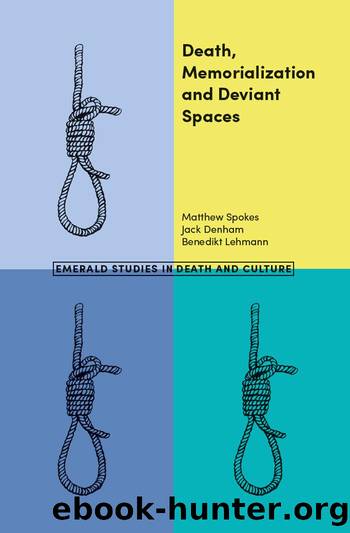Death, Memorialization and Deviant Spaces by Matthew Spokes Jack Denham Benedikt Lehmann

Author:Matthew Spokes,Jack Denham,Benedikt Lehmann
Language: eng
Format: epub
ISBN: 9781787565739
Publisher: Emerald Publishing
Published: 2018-08-17T00:00:00+00:00
3.2. NUMBER 25 AS PERCEIVED SPACE
Number 25, like Tyburn in the previous chapter, also contains elements of these spatial engagements of use, historical association and representation. Spatial practice is how space is used â the outcome of the individualâs choices and decisions inside of space. The Cromwell Street walkway is a perceived space in its existence as a connection between nodes of urban life in the first instance, and in the second, in its existence as a site of intense media coverage. It is a perceived space for those who pass through it as part of the ordinary flows of urban life, but also as a space where the symbolism of death has been layered by the media as such to encourage the consumption of death â interpreted as what Lefebvre (1991) refers to as daily reality and urban reality, respectively.
In the first instance, then, the walkway is a pass-through between Cromwell Street and St Michaelâs Square. It is used by passers-by who, for over a decade now, have been utilising this fresh cut-through as they do their daily reality inside of an urban reality that has been reshaped by death; this has altered the flow of pedestrian traffic, repositioning the church onto a corner and bringing the car park temporally closer to Gloucester Park to the south, the Royal Hospital to the north, and the rest of the Victorian housing that makes up eastern Gloucester. It has altered the rhythmic flow of urban life that Lefebvre has argued constitutes the social â its ârecognisable ways, stops, silences, blanks, resumptions and intervalsâ (2004, p. 78) have been amended by this memorial.
It connects private and public spaces together, the car park with the housing estate, and the supermarket with western Gloucester. By contrast, the spatial practice of Tyburn included an impromptu, informal network of pathways that problematised the established function of urban reality, the flows of people through the Cromwell Street Walkway are not open to interpretation or improvement. They are instead corralled by the local authority through this new connection between the established nodes of the city. For the local authority, the Cromwell Street Walkway should fulfil the spatial practice of a walkway and nothing more.
In the second instance, the walkway is a perceived space through its media sensationalisation as a place of death and suffering. The Westsâ have been the subject of numerous films, have been covered in television programmes and have been the subject of several books (for example, Woodrow, 2012; Jarrold, 2011; Anderson, 2014). They have been cemented by the news media as infamous popular cultural icons of death and violence. This media exposure will have altered the perception of the Cromwell Street space by attaching symbolic representational association with death. However, I will avoid going into any more detail here, as the results of this will be touched upon under the subheading representational space and will be further unpacked as part of theatrical space towards the end.
Download
This site does not store any files on its server. We only index and link to content provided by other sites. Please contact the content providers to delete copyright contents if any and email us, we'll remove relevant links or contents immediately.
They Both Die at the End by Adam Silvera(9679)
Thirteen Reasons Why by Jay Asher(8744)
The Space Between by Michelle L. Teichman(6818)
Suicide Notes by Michael Thomas Ford(4703)
Tuesdays with Morrie by Mitch Albom(4607)
Suicide: A Study in Sociology by Emile Durkheim(2950)
The Checklist Manifesto by Atul Gawande(2745)
Tuesdays With Morrie by Mitch Albom(2636)
In the Woods by Tana French(2502)
Bossypants by Tina Fey(2429)
Robin by Dave Itzkoff(2301)
Olive Kitteridge by Elizabeth Strout(2275)
No Ashes in the Fire by Darnell L Moore(2253)
Reservoir 13 by Jon McGregor(2219)
End of Days by Sylvia Browne(2088)
Bus on Jaffa Road by Mike Kelly(2083)
All Things New by John Eldredge(2083)
Scar Tissue by Anthony Kiedis(2042)
No Time to Say Goodbye(2029)
